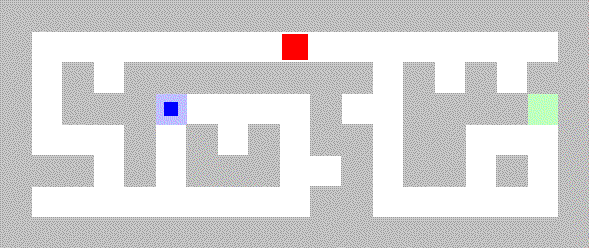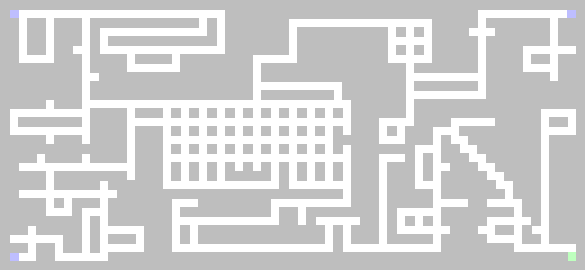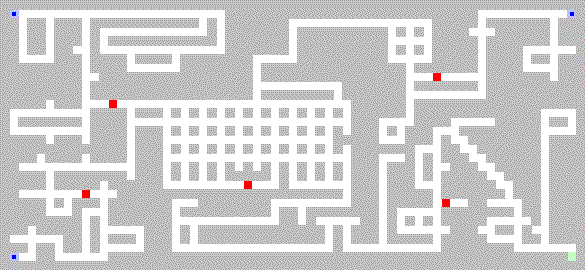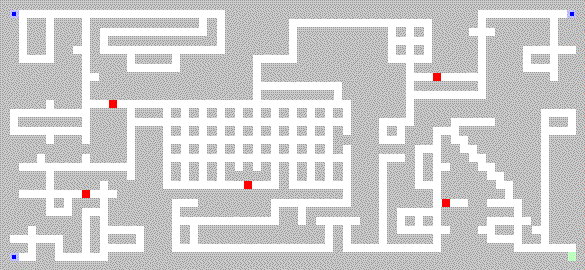17
6
UPDATE: Added a Python framework to get started.
The space-station has been overtaken by crusher-bots. You must direct as many of our expensive and fragile tech-bots called "rabbits" to an exit teleporter before the station self-destructs, but the crusher-bots are patrolling the corridors.
Your program is given an ASCII map, and each turn is told where the crusher-bots are and your current rabbits are. Your program should then move your rabbits toward the exit teleporter while avoiding the crusher-bots.

Execution
Run the Python 2 controller with:
python controller.py <mapfile> <turns> <seed> <runs> <prog>...
<prog> can be <interpreter> <yourprog> or similar.
The seed is a small integer used for the crusher and your program PRNG so that runs are repeatable. Your program should perform consistently regardless of the actual seed used. If seed is zero, the controller will use a random seed for each run.
The controller will run your program with the name of the map text file and seed as arguments. Eg:
perl wandomwabbits.pl large.map 322
If your program uses a PRNG, you should initialise it with the given seed. The controller then sends your program updates through STDIN and reads your rabbit movements through STDOUT.
Each turn the controller will output 3 lines:
turnsleft <INT>
crusher <x,y> <movesto|crushes> <x,y>; ...
rabbits <x,y> <x,y> ...
then waits for the program to output one line:
move <x,y> to <x,y>; ...
UPDATE: Your program will have 2 seconds to initialise before the first lines are sent by the controller.
If your program takes longer than 0.5 seconds to respond with moves after the controller rabbit location input, the controller will exit.
If there are no rabbits on the grid, the rabbits line will have no values, and your program should output a bare "move" string line.
Remember to flush your program output stream each turn or the controller may hang.
Example
prog input:
turnsleft 35
crusher 22,3 crushes 21,3; 45,5 movesto 45,4
rabbits 6,4 8,7 7,3 14,1 14,2 14,3
prog output:
move 14,3 to 14,4; 14,2 to 14,3; 6,4 to 7,4
Controller logic
The logic for each turn:
- if turns left is zero, print score and exit.
- for each empty start cell, add a rabbit if no crusher in sight.
- for each crusher, decide move direction (see below).
- for each crusher, move if possible.
- if crusher is at a rabbit location, remove rabbit.
- output turnsleft, crusher actions, and rabbit locations to program.
- read rabbit move requests from program.
- if a rabbit not exist or move not possible, skip.
- plot each new location of rabbits.
- if rabbit hits a crusher, rabbit is destroyed.
- if rabbit is in exit teleporter, rabbit is removed and score increased.
- if rabbits collide, they are both destroyed.
Each crusher always has a heading direction (one of NSEW). A crusher follows this navigation logic each turn:
- If one or more rabbits are visible in any of 4 orthogonal directions, change direction to one of the closest rabbits. Note that crushers cannot see past another crusher.
- else choose randomly between open forward,left,right options if possible.
- else if obstacles (wall or other crusher) in front, left, and right, set direction to behind.
Then for each crusher:
- If there is no obstacle in new crusher direction, move (and possibly crush).
The map symbols
The map is a rectangular grid of ASCII characters. The map is made up of walls
#, corridor spaces , rabbit start positions s, exit teleporters e, and
crusher starting locations c. The top left corner is location (0,0).
Small map
###################
# c #
# # ######## # # ##
# ###s # ####e#
# # # # ## ## #
### # ### # ## # #
# ## #
###################
Test map
#################################################################
#s ############################ s#
## ## ### ############ # ####### ##### ####### ###
## ## ### # # ####### ########## # # #### ###### ###
## ## ### # ############ ####### ########## ##### ####### ###
## ## ## # ####### ########## # # ##### #### #
## ### #### #### ######## ########## ##### #### ## ###
######### #### ######## ################ ####### #### ###
######### ################# ################ c ####### ###
######### ################## ####### ####### ###########
######### ################## ######## ####### ###########
##### ### c ###### ###################
# #### ### # # # # # # # # # # ###### ############## #
# ####### #### ### #### ##### ## #
# #### ### # # # # # # # # # # ### # ### ######### #
##### ### #### ### ##### ### # ######## ####
############## ### # # # # # # # # # # ####### ## ####### ####
#### #### #### ### ### # # ### ###### ####
## ### # # # # # # # # # # ### ### # ### ##### ####
##### ######## ### # # # ##### # # # # ### ### # ##### #### ####
##### ##### ###### c # ### ### ###### ### ####
## c ######################### ### ##### ####### ### ####
##### # ### ####### ######## ### ##### c ## ## ####
##### # ####### ########## ## ######## # ######## ## ####
######### # ####### ## # ## # # # ##### # ####
### ##### # ### # ############## # ### # ### ## # ####
# ## # ### ### # ############## # ### ##### ##### ## ####
### ## ## # ### # ######## #
#s ## ###################################################e#
#################################################################
Example large map run

Score
To evaluate your program, run the controller with the test map, 500 turns, 5 runs, and seed of 0. Your score is the total number of rabbits successfully teleported off the station to safety. In the event of a tie, the answer with the most votes will win.
Your answer should include a title with entry name, language used, and score. In the answer body, please include the controller score output complete with seed numbers so that others can repeat your runs. For example:
Running: controller.py small.map 100 0 5 python bunny.py
Run Seed Score
1 965 0
2 843 6
3 749 11
4 509 10
5 463 3
Total Score: 30
You can use standard and freely available libraries but the standard loopholes are forbidden. You must not optimise your program for a given seed, turn count, map feature set, or other parameters. I reserve the right to change the map, turn count, and seed if I suspect a violation of this rule.
Controller code
#!/usr/bin/env python
# Control Program for the Rabbit Runner on PPCG.
# Usage: controller.py <mapfile> <turns> <seed> <runs> <prog>...
# Tested on Python 2.7 on Ubuntu Linux. May need edits for other platforms.
# v1.0 First release.
# v1.1 Fixed crusher reporting bug.
# v1.2 Control for animation image production.
# v1.3 Added time delay for program to initialise
import sys, subprocess, time, re, os
from random import *
# Suggest installing Pillow if you don't have PIL already
try:
from PIL import Image, ImageDraw
except:
Image, ImageDraw = None, None
GRIDLOG = True # copy grid to run.log each turn (off for speed)
MKIMAGE = False # animation image creation (much faster when off)
IMGWIDTH = 600 # animation image width estimate
INITTIME = 2 # Allow 2 seconds for the program to initialise
point = complex # use complex numbers as 2d integer points
ORTH = [1, -1, 1j, -1j] # all 4 orthogonal directions
def send(proc, msg):
proc.stdin.write((msg+'\n').encode('utf-8'))
proc.stdin.flush()
def read(proc):
return proc.stdout.readline().decode('utf-8')
def cansee(cell):
# return a dict of visible cells containing robots with distances
see = {} # see[cell] = dist
robots = rabbits | set(crushers)
if cell in robots:
see[cell] = 0
for direc in ORTH:
for dist in xrange(1,1000):
test = cell + direc*dist
if test in walls:
break
if test in robots:
see[test] = dist
if test in crushers:
break # can't see past them
return see
def bestdir(cr, direc):
# Decide in best direction for this crusher-bot
seen = cansee(cr)
prey = set(seen) & rabbits
if prey:
target = min(prey, key=seen.get) # Find closest
vector = target - cr
return vector / abs(vector)
obst = set(crushers) | walls
options = [d for d in ORTH if d != -direc and cr+d not in obst]
if options:
return choice(options)
return -direc
def features(fname):
# Extract the map features
walls, crusherstarts, rabbitstarts, exits = set(), set(), set(), set()
grid = [line.strip() for line in open(fname, 'rt')]
grid = [line for line in grid if line and line[0] != ';']
for y,line in enumerate(grid):
for x,ch in enumerate(line):
if ch == ' ': continue
cell = point(x,y)
if ch == '#': walls.add(cell)
elif ch == 's': rabbitstarts.add(cell)
elif ch == 'e': exits.add(cell)
elif ch == 'c': crusherstarts.add(cell)
return grid, walls, crusherstarts, rabbitstarts, exits
def drawrect(draw, cell, scale, color, size=1):
x, y = int(cell.real)*scale, int(cell.imag)*scale
edge = int((1-size)*scale/2.0 + 0.5)
draw.rectangle([x+edge, y+edge, x+scale-edge, y+scale-edge], fill=color)
def drawframe(runno, turn):
if Image == None:
return
scale = IMGWIDTH/len(grid[0])
W, H = scale*len(grid[0]), scale*len(grid)
img = Image.new('RGB', (W,H), (255,255,255))
draw = ImageDraw.Draw(img)
for cell in rabbitstarts:
drawrect(draw, cell, scale, (190,190,255))
for cell in exits:
drawrect(draw, cell, scale, (190,255,190))
for cell in walls:
drawrect(draw, cell, scale, (190,190,190))
for cell in crushers:
drawrect(draw, cell, scale, (255,0,0), 0.8)
for cell in rabbits:
drawrect(draw, cell, scale, (0,0,255), 0.4)
img.save('anim/run%02uframe%04u.gif' % (runno, turn))
def text2point(textpoint):
# convert text like "22,6" to point object
return point( *map(int, textpoint.split(',')) )
def point2text(cell):
return '%i,%i' % (int(cell.real), int(cell.imag))
def run(number, nseed):
score = 0
turnsleft = turns
turn = 0
seed(nseed)
calltext = program + [mapfile, str(nseed)]
process = subprocess.Popen(calltext,
stdin=subprocess.PIPE, stdout=subprocess.PIPE, stderr=errorlog)
time.sleep(INITTIME)
rabbits.clear()
crushers.clear()
crushers.update( dict((cr, choice(ORTH)) for cr in crusherstarts) )
while turnsleft > 0:
# for each empty start cell, add a rabbit if no crusher in sight.
for cell in rabbitstarts:
if cell in rabbits or set(cansee(cell)) & set(crushers):
continue
rabbits.add(cell)
# write the grid to the runlog and create image frames
if GRIDLOG:
for y,line in enumerate(grid):
for x,ch in enumerate(line):
cell = point(x,y)
if cell in crushers: ch = 'X'
elif cell in rabbits: ch = 'o'
runlog.write(ch)
runlog.write('\n')
runlog.write('\n\n')
if MKIMAGE:
drawframe(number, turn)
# for each crusher, decide move direction.
for cr, direc in crushers.items():
crushers[cr] = bestdir(cr, direc)
# for each crusher, move if possible.
actions = []
for cr, direc in crushers.items():
newcr = cr + direc
if newcr in walls or newcr in crushers:
continue
crushers[newcr] = crushers.pop(cr)
action = ' movesto '
# if crusher is at a rabbit location, remove rabbit.
if newcr in rabbits:
rabbits.discard(newcr)
action = ' crushes '
actions.append(point2text(cr)+action+point2text(newcr))
# output turnsleft, crusher actions, and rabbit locations to program.
send(process, 'turnsleft %u' % turnsleft)
send(process, 'crusher ' + '; '.join(actions))
rabbitlocs = [point2text(r) for r in rabbits]
send(process, ' '.join(['rabbits'] + rabbitlocs))
# read rabbit move requests from program.
start = time.time()
inline = read(process)
if time.time() - start > 0.5:
print 'Move timeout'
break
# if a rabbit not exist or move not possible, no action.
# if rabbit hits a crusher, rabbit is destroyed.
# if rabbit is in exit teleporter, rabbit is removed and score increased.
# if two rabbits collide, they are both destroyed.
newrabbits = set()
for p1,p2 in re.findall(r'(\d+,\d+)\s+to\s+(\d+,\d+)', inline):
p1, p2 = map(text2point, [p1,p2])
if p1 in rabbits and p2 not in walls:
if p2-p1 in ORTH:
rabbits.discard(p1)
if p2 in crushers:
pass # wabbit squished
elif p2 in exits:
score += 1 # rabbit saved
elif p2 in newrabbits:
newrabbits.discard(p2) # moving rabbit collision
else:
newrabbits.add(p2)
# plot each new location of rabbits.
for rabbit in newrabbits:
if rabbit in rabbits:
rabbits.discard(rabbit) # still rabbit collision
else:
rabbits.add(rabbit)
turnsleft -= 1
turn += 1
process.terminate()
return score
mapfile = sys.argv[1]
turns = int(sys.argv[2])
argseed = int(sys.argv[3])
runs = int(sys.argv[4])
program = sys.argv[5:]
errorlog = open('error.log', 'wt')
runlog = open('run.log', 'wt')
grid, walls, crusherstarts, rabbitstarts, exits = features(mapfile)
rabbits = set()
crushers = dict()
if 'anim' not in os.listdir('.'):
os.mkdir('anim')
for fname in os.listdir('anim'):
os.remove(os.path.join('anim', fname))
total = 0
print 'Running:', ' '.join(sys.argv)
print >> runlog, 'Running:', ' '.join(sys.argv)
fmt = '%10s %20s %10s'
print fmt % ('Run', 'Seed', 'Score')
for n in range(runs):
nseed = argseed if argseed else randint(1,1000)
score = run(n, nseed)
total += score
print fmt % (n+1, nseed, score)
print 'Total Score:', total
print >> runlog, 'Total Score:', total
The controller makes a text log of the runs in run.log and a series of images
in the anim directory. If your Python installation can't find the PIL image
library (download as Pillow), no images will be generated. I have been animating
the image series with ImageMagick. Eg:
convert -delay 100 -loop 0 anim/run01* run1anim.gif
You are welcome to post interesting animations or images with your answer.
You can turn these features off and speed up the controller by setting GRIDLOG
= False and/or MKIMAGE = False in the first few lines of the controller program.
Suggested Python framework
To help get started, here is a framework in Python. The first step is to read in the map file and find paths to the exits. In each turn there should be some code to store where the crushers are, and code that decides where to move our rabbits. The simplest strategy to start with is moving the rabbits towards an exit ignoring the crushers -- some rabbits might get through.
import sys, re
from random import *
mapfile = sys.argv[1]
argseed = int(sys.argv[2])
seed(argseed)
grid = [line.strip() for line in open(mapfile, 'rt')]
#
# Process grid to find teleporters and paths to get there
#
while 1:
msg = sys.stdin.readline()
if msg.startswith('turnsleft'):
turnsleft = int(msg.split()[1])
elif msg.startswith('crusher'):
actions = re.findall(r'(\d+),(\d+) (movesto|crushes) (\d+),(\d+)', msg)
#
# Store crusher locations and movement so we can avoid them
#
elif msg.startswith('rabbits'):
moves = []
places = re.findall(r'(\d+),(\d+)', msg)
for rabbit in [map(int, xy) for xy in places]:
#
# Compute the best move for this rabbit
newpos = nextmoveforrabbit(rabbit)
#
moves.append('%u,%u to %u,%u' % tuple(rabbit + newpos))
print 'move ' + '; '.join(moves)
sys.stdout.flush()


Is it allowed to simulate the controller, with the exact same RNG? This would effectively make the crushers deterministic, allowing you to predict their behaviour and avoid them. Hell, you could probably make one or a few 'bait rabbits' to keep the crushers busy while setting up an unbothered highway of rabbits – orlp – 2015-03-25T05:01:57.363
No, you may not simulate the RNG (or record it for a particular seed). The crushers are designed to be NOT deterministic, so this is a code challenge to make a strategy that is likely to avoid them. The 'bait rabbit' idea is certainly ok though. I am expecting some strategies involving sacrificial rabbits. – Logic Knight – 2015-03-25T05:15:28.510
If seed is 0, won't each run use a random seed? – TheNumberOne – 2015-03-27T14:16:53.837
Yes. If the controller seed is zero, it will use (and issue to the test program) a random seed for each run. This seed is reported with the score of the run. Feeding this seed back into the controller should cause that exact run (and score) to be verified. It is a bit complex, but it was the best way I could figure to enable replicating runs (deterministic) and allow randomness in controller and test program behaviour. – Logic Knight – 2015-03-27T14:31:34.637